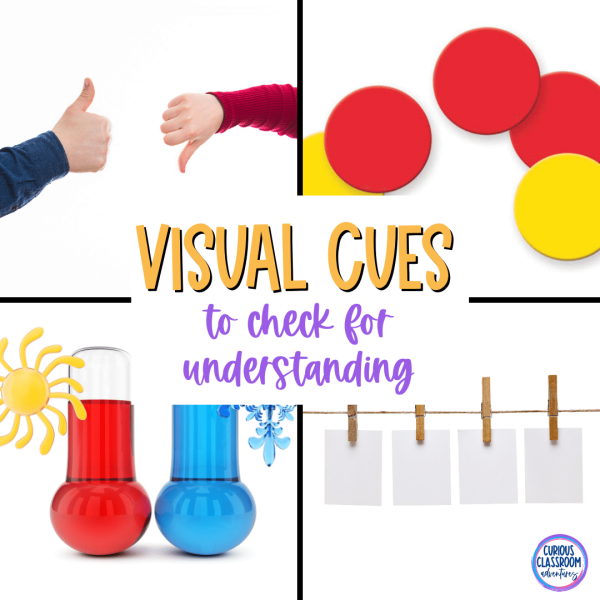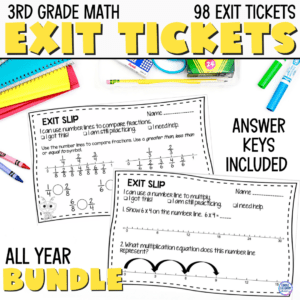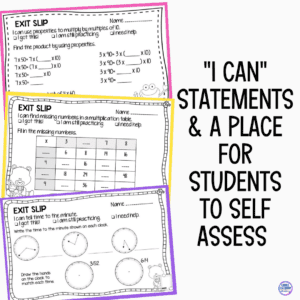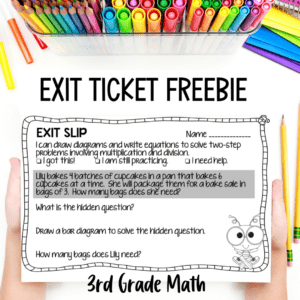As an upper elementary teacher, it’s important to regularly check for understanding when teaching new material. After all, what good is a lesson if they didn’t get it? Visual cues can help teachers check for understanding while keeping their students engaged. Let’s jump right in with 5 fun and easy ways to gauge student comprehension.
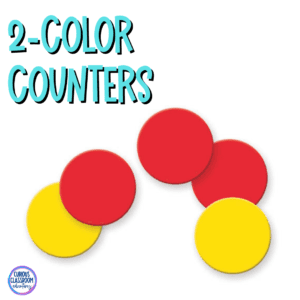
Two Color Counters:
This is one of the easiest check for understanding visual cues to set up and use. Give each student a two-color counter. Designate one color for “I understand,” and one color for “I still need help understanding.”
At various points throughout your lesson, ask your students to place their counter with the color side up that lets you know if they understand or need help. This simple visual cue allows every student to actively participate without having to vocalize their comprehension level out loud.
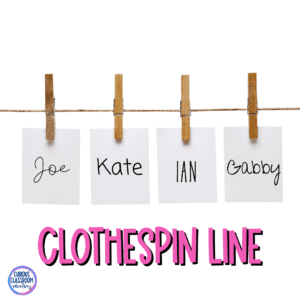
Clothespin line:
Another great way to check for understanding is the clothespin line. To set this one up, hang a piece of twine or rope across a bulletin board or along the base of your whiteboard. Add a couple of signs to label one end of the rope “I could teach this to someone else,” and the other end of the rope “I need more time to understand this.”
Have each child write their name on a clothespin and hang it on the rope to show how they are feeling about the lesson. Once, students have done this one, you can reuse the clothespins over and over throughout the year. This is also great for offering your students a chance to move a bit as well.

Stoplight System:
Just like a two-color counter system, this check for understanding visual cue uses colored cards (or plastic cups) to signify understanding level. Each student is given three cards—red, yellow, and green—to indicate their current level of understanding. Red indicates complete confusion; yellow shows that they partially understand but still have questions; and green means they have fully mastered the skill/concept being taught.
Students will keep one color on top of the stack that matches up with how they feel about the skill or concept they are working on. This system is great because it allows students to communicate their understanding levels without having to talk out loud in front of the class.

Thumbs Up/Down System:
This is a classic method for quickly getting an idea of how well your students understand the material you just taught. Before sending them off on their own, ask them to give a thumbs up if they think they have a good handle on the concept and a thumbs down if they need more help. It takes no time at all but gives you lots of useful information. You can also get creative and come up with different hand signals or have your students help create them.

Hot or Cold:
This one is a little silly and fun, but it works like a charm but its an easy way to guage the temperature of your students. Tell students that you will count to 3. On three you want them to act burning hot, fanning themselves with their hands and wiping sweat off their faces, if they really understand the lesson.
If they need more instruction or time to feel confident with the new material they should act like they are absolutely freezing, warming their hands, shivering, and rubbing their arms to stay warm. It’s an easy visual that allows you to check for understanding, and it’s a little fun movement that offers a brain break in the midst of learning.

Emojis:
Print out emojis of all kinds on card stock paper, cut them out, and voila! You now have kid-friendly visuals for your students to hold up allowing you to check for understanding! Emojis are also easy to recognize no matter what language or culture your students come from.
I like to have these quick checks throughout a lesson and then follow up with something on paper like exit tickets, which are also quick and easy but also give students an opportunity to prove their understanding in writing. I love how these math exit tickets include checkboxes at the top for kids to reflect and give you feedback on how well they understand the math concept of the day. You can try these out for yourself by downloading this free set of exit tickets for solving 2-step problems.
Visual cues are such an easy way to check for understanding in with your class without having anyone stand out or feel embarrassed about needing extra help on something new — plus it keeps things lighthearted and entertaining while empowering students through self-assessment! Enjoy trying these out!

